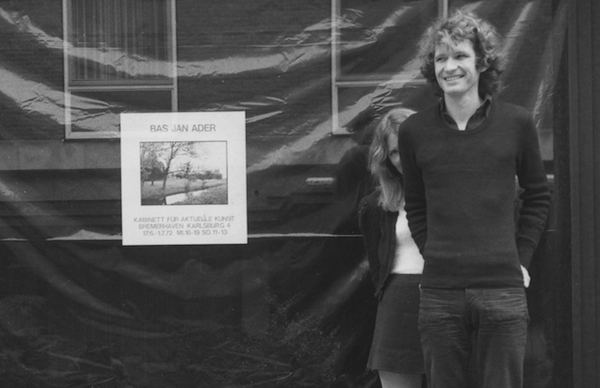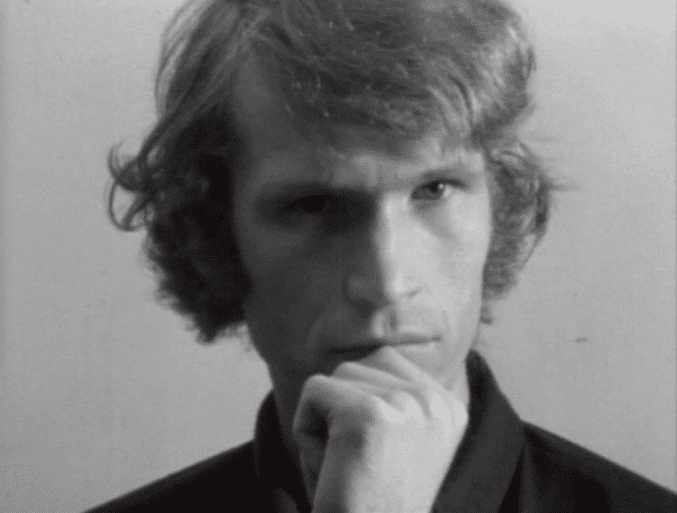Status Presumed dead Role Artist Nationality Dutch and American Died 1975 | Spouse(s) Mary Sue Ader-Anderson Name Bas Ader | |
 | ||
Known for Photography, film, video, performance and installation Movies Here Is Always Somewhere Else | ||
Here is always somewhere else the disappearance of bas jan ader 1 5
Bastiaan Johan Christiaan "Bas Jan" Ader (born 19 April 1942 – disappeared 1975) was a Dutch conceptual artist, performance artist, photographer and filmmaker. He had lived in Los Angeles, California for the last twelve years of his life. His work was in many instances presented as photographs and film of his performances. He made performative installations, including Please Don't Leave Me (1969).
Contents
- Here is always somewhere else the disappearance of bas jan ader 1 5
- The legacy of bas jan ader
- Early life and education
- Works
- Disappearance
- Exhibitions reception and impact
- References

Ader was lost at sea in 1975, attempting to cross the Atlantic Ocean from the US to England in the smallest boat ever. His deserted vessel was found off the coast of Ireland on 18 April 1976, offering few clues as to his fate.

The legacy of bas jan ader
Early life and education

Born on 19 April 1942, Ader grew up in Drieborg, a small village in the Dutch province of Groningen. His father, Bastiaan Jan Ader and his mother Johanna Adriana Ader-Appels were both Calvinist ministers. His father was executed in 1944 by the Nazis for his large scale endeavors to help Jewish compatriots to escape the Holocaust.

During adolescence, Ader took art classes at the Gerrit Rietveld Academy in Amsterdam, and later in the United States during a study abroad program. Ader graduated from the Otis College of Art and Design in 1965 with a BFA, and from the Claremont Graduate University in 1967. After graduating, he taught at various institutions, including Mt. San Antonio College, Immaculate Heart College, and the University of California, Irvine.
Works

Ader created a handful of photographs as well as several short black-and-white films in which he is the sole performer.
One of his most famous works, I'm too sad to tell you, consists of a 3-minute silent black-and-white movie of him crying, several photographs (long hair and short hair versions) and a post card mailed to his friends with the inscription "I'm too sad to tell you". Other films include him sitting on a chair on a pitched roof until he falls, one where he is hanging on a branch until his grip gives out and he falls into a stream, and a film in which he rides his bike into a canal.
In 1969–70 he anonymously published the satirical conceptual art magazine Landslide with his friend William Leavitt. The magazine featured “interviews” with nonexistent artists, such as “Brian Shitart”, and pranks such as “expandable sculpture” which was five packing peanuts in an envelope. Although satirical of conceptual art, the magazine itself is considered a work of conceptual art.
In 1973 he made the work 'In search of the miraculous (One night in Los Angeles)', a series of photographs showing a lonely figure wandering through the night in L.A, searching everywhere with a torchlight. It was the first part of a [triptych]. The second part would be the record of his Atlantic crossing (see below), the third part a similar night time search somewhere in the Netherlands, again to be recorded in a series of photographs. He had arranged for a choir to sing sea shanties at a gallery in Los Angeles before his departure from Cape Cod. A similar performance was planned upon his arrival in a museum in Groningen, Netherlands. Due to his loss at sea, the triptych was never completed. The title “In Search of the Miraculous” was a reference to P.D. Ouspensky's mystical book In Search of the Miraculous.
Disappearance
On 9 July 1975, Ader set off in a 13 ft (4.0 m) modified “Guppy 13” pocket cruiser named Ocean Wave, to make his single-handed west–east crossing of the North Atlantic. He estimated that the voyage should take him some two and a half months. His unmanned boat was found nine months after he had set sail, floating nearly vertically in the water, bow down, 200 nautical miles (360 km's) due west of Land's End, 100 nautical miles SW of Ireland. Ocean Wave was found by Spanish fishermen who took her to La Coruña from where she was stolen somewhere between 18 May and 7 June 1976.
It is unknown how Ader met his death. It is the source of much speculation. Sightings of him and his boat off the American East Coast and the Azores are unconfirmed. Ader was an accomplished sailor, having been one of a two-handed crew, sailing a yacht from Morocco to California in 1962-63. His brother Erik, an experienced ocean sailor, thinks that the fixed point on the boat to which his life line was attached was ripped out when he fell overboard in heavy weather. His conclusion is based on interviews with people in Spain who saw his retrieved boat before it was stolen.
Ader's mother wrote the poem "From the Deep Waters of Sleep" on 12 October 1975, after having what she described as a premonition of his death:
"From the deep waters of sleep I wake up to consciousness.
In the distance I hear a train rumbling in the early morning.
It is going East and passes the border. Then it will stop."
"I feel my heart beating too. It will go on beating for some time.
Then it will stop.
I wonder if the little heart that has beaten with mine, has stopped.
When he passed the border of birth, I laid him at my breast,
Rocked him in my arms.
He was very small then."
"A white body of a man, rocked in the arms of the waves,
Is very small too."
"What are we in the infinity of ocean and sky?
A small baby at the breast of eternity."
"Have you heard of happiness
Springing from a deep well of sorrow?
Of love, springing from pain and despondency, agony and death?
Such is mine."
Psalm 30:2
Exhibitions, reception and impact
In 1961, Ader exhibited his works at three galleries in Washington DC and received a positive review in The Washington Post. He became a minor sensation, being interviewed by The Voice of America and by the press in his native Holland. In 1967, he gained his Master of Fine Arts with his project Implosion at Claremont Graduate School.
During his lifetime, Ader had solo exhibitions at the Chouinard Art School, Los Angeles (1970), the Pomona College Museum of Art (1972), and the galleries Art & Project, Amsterdam (1972), Kabinett für Aktuelle Kunst, Bremerhaven, Germany (1972, 1974) and the Claire S. Copley Gallery, blogs.getty.edu; accessed 8 April 2015.
Ader held a two-person exhibition with William Leavitt at the Nova Scotia School of Art and Design (1972), a conceptual hotbed at the time, as well as a number of group exhibitions in Europe and the US with such artists as Leavitt, Ger van Elk, Gilbert & George, Jack Goldstein, Allen Ruppersberg, John Baldessari, and Marcel Broodthaers among others. His work was also included in the important international survey exhibitions Prospekt ’71: Projektion at the Kunsthalle Düsseldorf (1971), and Sonsbeek ’71, Groningen, Holland. (1971).
Since his disappearance, Ader's work has been exhibited in solo exhibitions at institutions worldwide including the Stedelijk Museum Amsterdam (1988), the Museum Boijmans Van Beuningen, Rotterdam (1993, 2006), Kunstverein München, Munich (1994, 2000), Musée d'Art Moderne de la Ville de Paris (1994), Kunstverein Braunschweig, Germany (2000), Portikus, Frankfurt (2003), and the Museo Tamayo Arte Contemporáneo, Mexico City (2004).
Ader's first retrospective in the United States took place in 1999 at the University of California, Irvine, and travelled to two other venues; the Mary Porter Sesnon Art Gallery, University of California, Santa Cruz, and the Sweeney Art Gallery at the University of California, Riverside. It was curated by Brad Spence with a catalogue including contributions by Thomas Crow, Jan Tumlir, and Spence. In 2006, Camden Arts Centre, London held a European retrospective of his works which travelled to the Museum Boijmans Van Beuningen, Rotterdam and the Kunsthalle, Basel, Switzerland.
More recent solo exhibitions include In Search of the Miraculous: 30 Years Later, Centro Gallego de Arte Contemporáneo, Santiago de Compostela, Spain (2010), Suspended Between Laughter and Tears, Pitzer Art Galleries, Pitzer College, Claremont CA (2010), which travelled to the Museo de Arte Zapopan, Mexico, and the artist's first Italian retrospective Tra Due Mondi, MAMbo, Museo d'Arte Moderna di Bologna, Bologna, Italy (2013). Metro Pictures, NYC, had a mini - survey of his work during summer, 2016. So did Simon Lee Gallery in London.
Erika Yeomans' conceptual documentary In Search of Bas Jan's Miraculous (1998, 40 minutes, mixed media) on Ader's life and art was featured on This American Life in 1996.
Inspired by Ader, digital movie pioneer Rene Daalder proposed a new genre of art called “Gravity Art” in 2008. Gravity Art is based on the idea of gravity as a medium. Ader is seen as the founder of this genre for the themes in his work of falling and letting go.
Here Is Always Somewhere Else is a 2007 documentary film about the life and work of Bas Jan Ader. As seen through the eyes of fellow emigrant filmmaker Rene Daalder, the picture becomes an overview of contemporary art films, featuring work from artists Tacita Dean, Rodney Graham, Marcel Broodthaers, Ger van Elk, Charles Ray, Wim T. Schippers, Chris Burden, Fiona Tan, Pipilotti Rist and many others.
Ader is one of the invited artists of the 2017 57th Venice Biennale.
